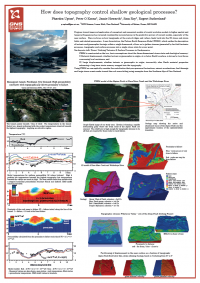CSDMS 2014 annual meeting poster Phaedra Upton
How does topography control shallow geological processes?
Jamie Howarth, GNS Science Lower Hutt NO STATE, New Zealand. j.howarth@gns.cri.nz
Abstract:
Over the past 30 years conceptual and numerical models of crustal evolution have evolved from simple 2D cross-sections to complex 3D models that achieve a qualitative, process-based understanding of key aspects of solid earth dynamics. However, recent progress toward improved application of these models to higher spatial and temporal frequencies has revealed considerable inconsistencies in their predictive powers, especially at the near surface. Here we focus on how topography at the scale of ridges and valleys feedback into the 3D stress and strain fields and related parameters. A new formulation, the Failure Earth Response Model (FERM), which unifies the description of tectonic and geomorphic forcings within a single framework, allows us to gather stresses generated by far field tectonics processes, topography and surface processes into a single stress state for every point. We can explicitly consider the contribution that pore pressure fluctuations, seismic accelerations, fault damage and large storm events make toward the rock mass failing using examples from the Southern Alps of New Zealand.
* Please acknowledge the original contributors when you are using this material. If there are any copyright issues, please let us know and we will respond as soon as possible.

